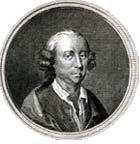William Shenstone Biography
Born in 1714 in Halesowen (now Worcestershire) England living at the family home 'The Leasowes'. Halesowen, which, up to the early years of the 18th century was in part of Shropshire. He was educated at Solihull Grammar School, where he met and became firm friends with the future poet Richard Jago, before going on to study at Pembroke College, Oxford, but without taking a degree. On inheriting 'The Leasowes' he spent much time and money on landscaping the estate.
He was a poet of diverse taste, his father recognising his talent when a young boy, had strived to send his son to Oxford to study theology but William showed no real interest, preferring poetry, odes, elegies, ballads and correspondence of which he was particularly proud.
Shenstone's work is somewhat self-conscious and pretty and is scarcely remembered today, with the possible exception of the pastoral poem The Schoolmistress (1742), written in the style of Edmund Spenser. This was praised by Dr. Johnson and Thomas Gray, the latter's Elegy written in a country churchyard (1751) being in a similar style.
William Shenstone died in 1763.
Ye birds! for whom I rear'd the grove,
With melting lay salute my love;
My Daphne with your notes detain,
Or I have rear'd my grove in vain.
...
-Melius, bunny venerit ipsa, canemus.
-Virg.
Imitation.
...
Ye shepherds give ear to my lay,
And take no more heed of my sheep:
They have nothing to do but to stray;
I have nothing to do but to weep.
...
Arbusta humilesque myricæ. Virg.
Ye shepherds so chearful and gay,
...
My banks they are furnish'd with bees,
Whose murmur invites one to sleep;
My grottos are shaded with trees,
And my hills are white-over with sheep.
...
